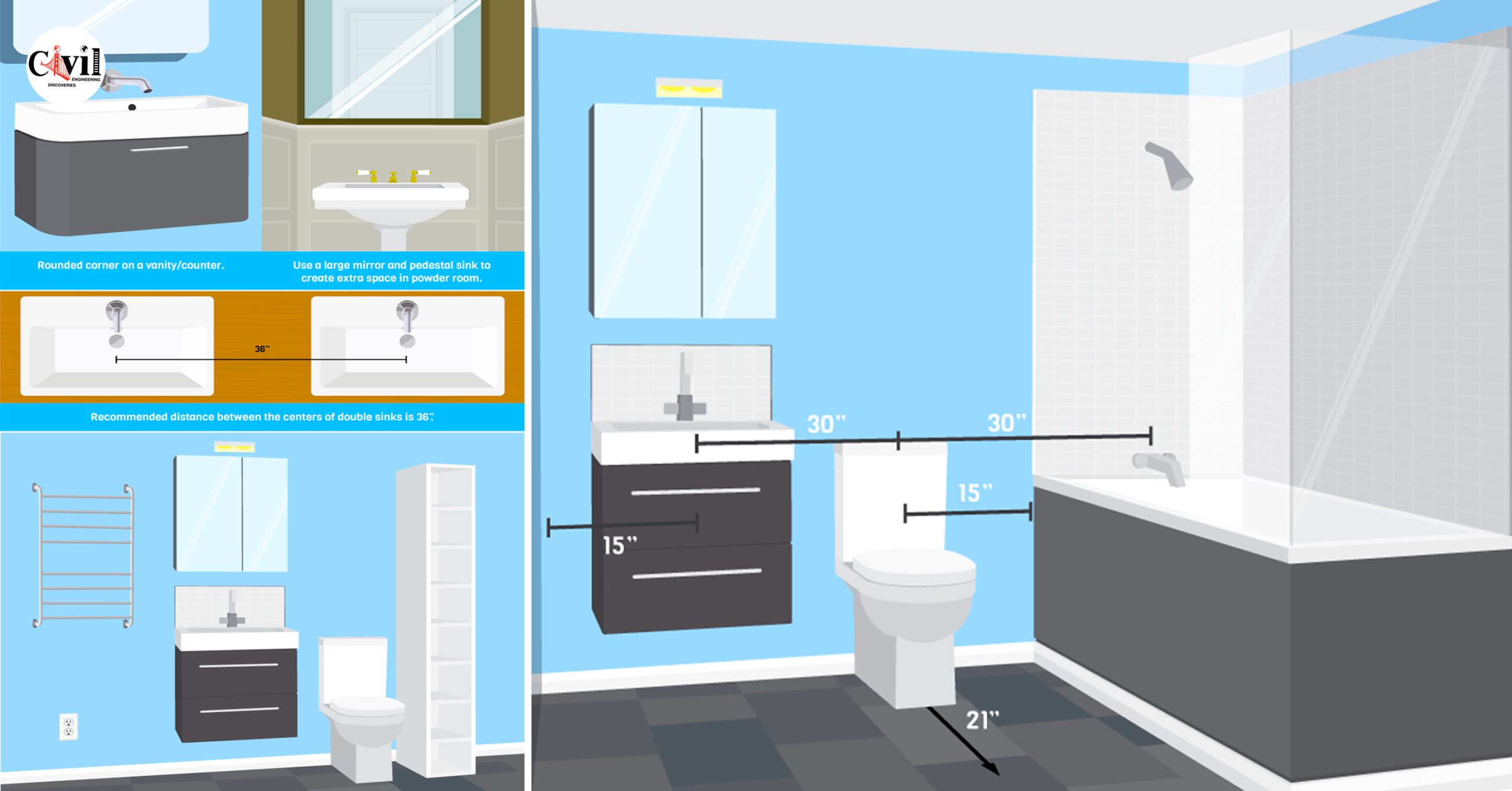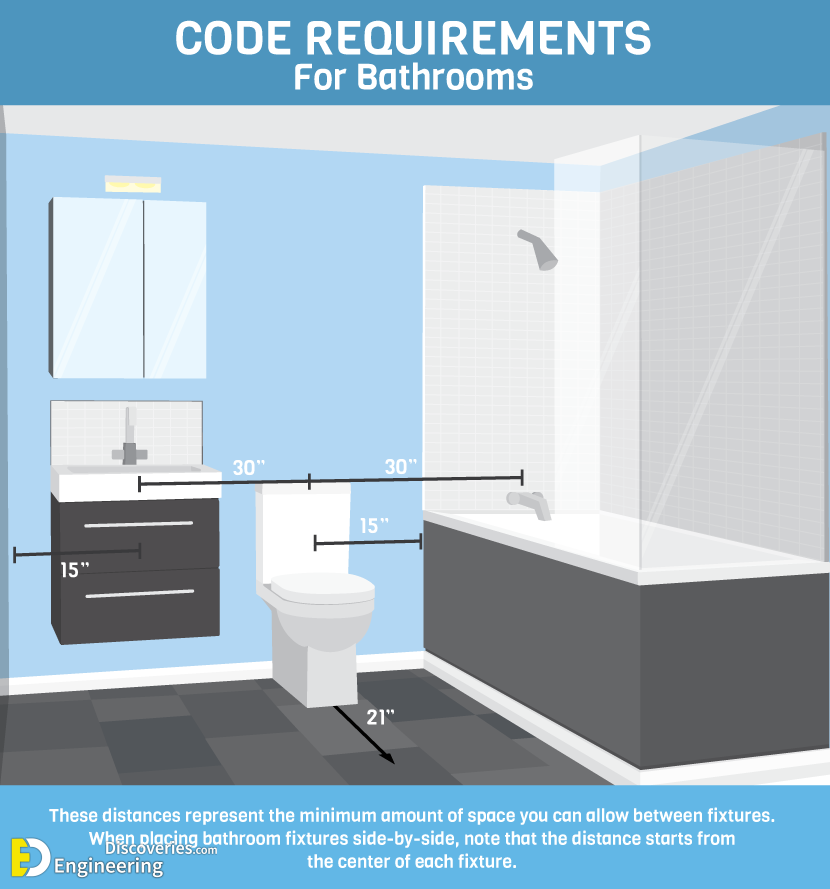No room in the house is as densely packed with services – electricity, water, sewer – as the bathroom. This density can result in a disorganized, inefficient space. At its worst, it can present a danger for the occupants. Because of this, it pays to know your building code as it relates to bathrooms – before you remodel.
Good design rules do not code and they are not required by law. But designing wisely means having a bathroom you will enjoy using. Plus, a well-designed bathroom gives your home added resale value when it comes time to sell.
Following Code in the Bathroom
The International Residential Code is a model code that was developed by an international standards organization for one- and two-family dwellings. Most municipalities in the United States and Canada have adopted this code. Some of these jurisdictions maintain the code exactly as it was written, while others introduce changes to adapt to the needs of their constituents.
Toilets
Provisions are made for clearing out plenty of space around the toilet. The purpose is to ease access not only to the toilet but to other services, such as the sink and bathing facilities.
- Front of Toilet: The front edge of the toilet must clear any possible obstruction – walls and other fixtures – by a minimum of 21”.
- Sides of Toilet: Code states that the toilets cannot be closer than “15 inches from its center to any side wall, partition, vanity or other obstruction, or closer than 30 inches center-to-center between toilets or adjacent fixtures.” In other words, you need to provide less space between the toilet and a wall (15 inches) than you do between the toilet and another service that provides water and/or has drainage (30 inches).
Showers
- Shower Size: Showers must be a minimum of 36” by 36”.
- Surrounds: Shower surrounds must extend at least 3” above the height of the shower head.
- Doors: Shower doors must swing outward.
Electrical
Electricity and water do not mix. For that reason, the code has strict specifications for electrical services, such as outlets, lights, and switches.
- Outlet Type: Outlets within 6 feet of a water source must be GFCI-protected.
- Outlet Type: Outlets within 6 feet of a water source must be GFCI-protected.
- Switch-Controlled Light: Bathrooms must have at least one wall switch-controlled light. The switch must be located near the entrance to the bathroom.
Ventilation
Remarkably enough, the code does not require a ventilation fan. At a minimum, a window of at least 3 square feet should be provided. This window should be able to open at least halfway.
Going Beyond Code: Rules for Good Design
Developed in large part by the National Kitchen and Bath Association, bathroom design rules are intelligent ideas that make bathrooms more efficient and enjoyable. None of these rules are required by law. Rather, they represent common sense ideas that bathroom industry professionals have developed from years of experience.
As a blanket rule, bathroom designers tend to agree that all code-required distances should be increased by 2” to 4”. In general, the more buffer room, the better.
Ventilation is a classic example of good design rules picking up where code leaves off. All bathroom designers are in agreement that bathrooms need powered ventilation fans, as the code minimum requirement for an operable window is considered archaic.
Family Bathrooms
In many homes, the family bathroom is the only bathroom. It has many uses: from a quick powder room for guests, all the way to a heavily-trafficked bathing facility for several family members.
- Counter Corners: Sharp corners on countertops can hurt your legs when you bump against them. Children can injure their faces or heads. Clipped or rounded corners should be used, rather than sharp corners.
- Towel Bars: Provide one towel bar per person using the bathroom’s bathing facility. If you lack wall space for multiple bars, you can install double or even triple bars, giving you space for several towels in the width of one towel bar.
- Lots of Storage: Most people think of bathroom storage as being under-cabinet space for toilet paper. But here is a novel concept: provide storage space separate from the vanity cabinet. Tall storage cabinets no more than 12” wide can fit in tight places and can satisfy most of your needs.
Master Bathroom
Master bathrooms are a luxury. Often they are attached to a master bedroom and contain all four services that define a full bathroom: toilet, sink, shower, and tub.
- Double-Basin Sink: Master bathrooms are large enough to accommodate two people. Double-basin sinks promote family peace and harmony because no one is fighting for dominance over that single sink.
- Hooks: Hooks mounted on the back of the door or in spaces too narrow for cabinets provide temporary “storage” for robes, towels, or clothing.
- Makeup Mirror: While not essential, a lighted extendable magnifying mirror is one item that defines your master bathroom as being luxurious.
- Enough Hot Water: A nice steamy bath is perfect at the end of a long day. Large soaking tubs, often found in master baths, use far more water than ordinary tubs. This means they also use more hot water. It is recommended that you upgrade your water heater so that it is at least two-thirds the capacity of the tub.
Powder Rooms
Powder rooms are where you send your guests so that your main bathroom (and your bath towels) remains unsullied (and unseen). Too tiny to contain bathing facilities, they are sometimes called half-bathrooms. Rather than the four services found in full bathrooms, powder rooms only have two – toilets and a sink.
In some respects, good design for powder rooms is the opposite of that for family and master bathrooms. Storage needs are minimal since you will not be storing bath towels or as many cleaning accessories. Storage can be reduced to just a small, covered wicker basket for extra toilet paper. Powder rooms have no need for multiple towel bars; at most, only one towel ring is needed.
- Pedestal Sinks: Big, imposing bathroom vanity cabinets steal room from space-starved powder rooms. A pedestal sink – simply a basin atop a stand – makes your bathroom feel larger.
- Large Mirrors: Many homeowners install a mirror proportional to the size of their powder room: small. But this only makes the room look tinier. Instead, put in a mirror that is as large as possible, as this will visually double your space.7
- Neutral Colors: Bright, in-your-face colors that look smashing in other parts of the house are, in guest bathrooms, literally in your face because the walls are so close. Try neutral colors in your powder room to avoid shocking your guests. Remember, neutral colors do not have to be boring. With warm tints (oranges, yellows) or cool shades (blues, greens), neutral colors can make as much of a statement as those loud colors.
Bathroom code and design rules are no limits imposed on you to kill your creativity. Instead, they are positive guidelines for approaching your bathroom remodeling project productively.
Click Here To See Amazing Bathroom Ideas To Inspire Your Next Remodel
Source: Fix





